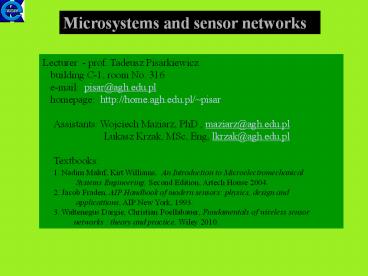Microsystems and sensor networks - PowerPoint PPT Presentation
Title:
Microsystems and sensor networks
Description:
Microsystems and sensor networks Lecturer - prof. Tadeusz Pisarkiewicz building C-1, room No. 316 e-mail: pisar_at_agh.edu.pl homepage: http://home.agh.edu.pl/~pisar – PowerPoint PPT presentation
Number of Views:46
Avg rating:3.0/5.0
Title: Microsystems and sensor networks
1
Microsystems and sensor networks
- Lecturer - prof. Tadeusz Pisarkiewicz
- building C-1, room No. 316
- e-mail pisar_at_agh.edu.pl
- homepage http//home.agh.edu.pl/pisar
- Assistants Wojciech Maziarz, PhD ,
maziarz_at_agh.edu.pl - Lukasz Krzak, MSc, Eng, lkrzak_at_agh.edu.pl
- Textbooks
- 1. Nadim Maluf, Kirt Williams, An Introduction
to Microelectromechanical - Systems Engineering, Second Edition,
Artech House 2004. - 2. Jacob Fraden, AIP Handbook of modern sensors
physics, design and - applicattions, AIP New York, 1993.
- 3. Waltenegus Dargie, Christian Poellabauer,
Fundamentals of wireless sensor - networks theory and practice, Wiley
2010.
2
Introduction
Definitions of terms used Sensor - a device that
converts a quantity of one kind into a quantity
of another kind (in most cases
into an electrical signal)
Lambda sensor for detection of oxygen in exhaust
gases of a car
3
Definitions of terms used, cont. Microsensor - a
sensor that has at least one physical dimension
at the submillimetre
level
The STJ-001 low-field magnetic microsensor in a
die form, with active area of 1 x 2 microns.
The die is 1.9 mm square and 300 microns thick.
It has four gold wirebonding pads which allow
four-point measurement of the device resistance.
The field sensitivity of the STJ-001 is 5 nT,
which is ten thousand times smaller than the
magnetic field of the Earth.
4
Definitions of terms used, cont. Actuator - a
device that converts an electrical signal into a
nonelectrical quantity
Electrostatic actuators with applied voltage V
which results in an attractive force (a)
parallel plate actuator with force normal to the
plate surfaces (b) electrostatic comb actuator
with attractive force in the direction of the
interdigitated teeth.
5
Definitions of terms used, cont. MEMS device
Micro-Electro-Mechanical System consisting of
microsensors, actuators and microelectronic
circuitry
Examples of MEMS accelerometers Analog Devices
ADXL250 (on the left) and Motorola dual-structure
microsystem before encapsulation (on the right)
6
1. Evolution of microsensors The vast increase
in microelectronics technology has caused that
the price-to-performance ratio of both sensors
and actuators had fallen remarkably behind
processors. Consequently, measurement systems
tended to be large and, more importantly,
expensive. Work therefore started to use the
microelectronic technologies to make
silicon-based sensors, the so-called microsensors.
World market for ICs and microsensors from 1990
to 2000
7
It is evident that the market for microsensors
lags well behind the market for ICs. The main
cause has been the relatively stable
price-performance (p/p) ratio of sensors and
actuators since 1960, as illustrated in the
Figure below.
This contrasts markedly with the p/p ratio of
ICs, which has fallen enormously between 1960 and
2000 and is now significantly below that for
sensors and actuators. As a consequence of these
changes, the cost of a measurement system is, in
general, dominated first by the cost of the
microactuator and second by the cost of the
microsensor.
Price-performance indicators for ICs, sensors,
and actuators
8
2. Evolution of MEMS The miniaturisation of a
sensor leads to producing of a microsensor,
secondly the integration of a microsensor and its
microelectronic circuitry gives so-called smart
sensor and thirdly, the integration of a
microsensor, a microactuator, and their
microelectronic circuitry produces a
microsystem. Many of the microsystems being
fabricated today employ silicon microtechnology
and this technology is commonly referred to as
MST (microsystem technology). Work to achieve
this goal started in the late 1980s, and there
has been enormous effort to fabricate
microelectromechanical systems (MEMS) using MST.
Elements of a MEMS chip together with overview of
its technology and applications
9
3. Emergence of micromachines Natural evolution
will then lead to MEMS devices that move around
by themselves. Such chips are commonly referred
to as micromachines microplanes, microrobots,
microcars, microsubmarines. Micromachines, if
developed, will need sophisticated microsensors
so that they can determine their location and
orientation in space and proximity to other
objects.
They should also be able to communicate with a
remote operator and hence will require a wireless
communication link - especially if they are asked
to enter the human body.
Dimensions of microsensors, MEMS, and
micromachines they are compared with some
everyday objects. The horizontal axis has a
logarithmic scale.
10
(No Transcript)































